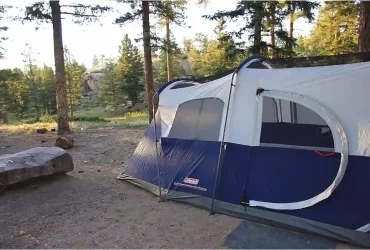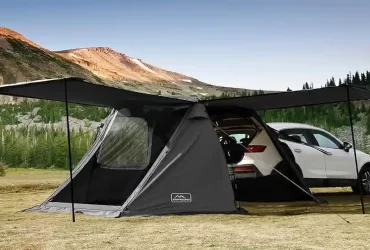Camping is a fantastic outdoor adventure that connects you with nature, provides tranquility, and produces lasting memories.
The only problem with sleeping in a damp tent is waking up uncomfortable and damp. You need to keep your tent dry inside if you want to really enjoy your camping experience.
To ensure a comfortable and dry camping experience, this article explores effective techniques and strategies.
Understanding the Importance of Keeping Your Tent Dry Inside
The importance of keeping your tent dry inside cannot be overstated. Getting a good night’s sleep is made easier when your tent is dry and warm.
In addition, it minimizes the risk of damage from moisture and mold to the tent, extending its lifespan. Also, a dry tent prevents damage from water to your gear and belongings.
Choosing the Right Tent

It is essential to choose the right tent if you wish to ensure a dry interior. In choosing a tent, you should keep the following factors in mind:
Factors to Consider
Waterproof Materials: Ensure that the tent you choose is waterproof, made from high-quality materials such as nylon or polyester. It is also important that the rainfly on the tent is waterproof to ensure that it provides additional protection.
Sealed Seams: Seal tent seams yourself with seam sealant if you cannot find tents with sealed seams. It prevents water from permeating through the stitching when seams are sealed.
Sturdy Construction: Tent frames and pole attachments that are properly constructed can withstand heavy rain and wind, reducing leakage risks.
Also like this:
Setting Up Your Tent Properly
Keeping the tent interior dry requires proper tent setup. Here are the steps you need to follow for a successful setup:
Finding a Suitable Campsite
It is recommended that you choose a campsite that is elevated and far from potential water sources such as rivers and depressions. Water can accumulate in low-lying areas where you set up your tent.
Preparing the Ground

You should clear the ground of rocks, sticks, and other debris to prevent the tent floor from being damaged. Make sure your groundsheet or footprint is waterproof by using one.
Using a Groundsheet or Footprint
The groundsheet or footprint is a layer of waterproof fabric placed beneath your tent’s floor to prevent moisture from entering. For water to not pool between the groundsheet and tent, ensure it is slightly larger than the tent footprint.
Pitching the Tent Correctly
To pitch your tent, follow the instructions provided by the manufacturer. Rainfly must be properly secured in order to provide maximum protection from rain and condensation.
Managing Moisture Inside the Tent
Water can still accumulate inside a tent even if it’s well-constructed and set up properly. The following tips will help you manage moisture:
Ventilation and Airflow

Keep the tent’s interior air circulating by opening the vents or mesh panels. Fresh air can circulate and moisture can escape, reducing condensation.
Using a Rainfly or Tarp

In clear weather, you should cover your tent with a rainfly or tarp. By doing so, you are adding an additional layer of protection against rain and limiting the chance of moisture entering your tent.
Dealing with Condensation
Tents are prone to condensation, especially in humid environments. To remove moisture from the interior walls, wipe them clean with a towel or cloth. Condensation can be reduced by using a tent fan or dehumidifier.
Also like this:
Taking Precautions in Wet Weather
You must take additional precautions to keep your tent dry inside when camping in wet weather. You may want to consider the following tips:
Keeping Gear and Clothing Dry
Waterproof bags or dry sacks should be used to store wet gear and clothing in order to prevent moisture from spreading inside the tent. Items that are wet can be hung outside or in a vestibule if possible.
Properly Storing Wet Items
In order to prevent dampness from occurring with dry gear, store wet items in separate bags or containers that you can’t dry immediately.
Using a Vestibule or Porch Area
Providing additional space to store wet items outside the main sleeping area is possible with a tent with a vestibule or porch area. Maintaining a clutter-free interior is made easier by this method.
Maintaining and Cleaning Your Tent

It is important to maintain and clean your tent regularly in order to increase its lifespan and ensure that its interior stays dry. These are the guidelines to follow:
Regular Inspection and Repairs
Ensure your tent is kept in good condition by checking for wear, tears, and damaged seams on a regular basis. Use a patch kit or seam sealant to repair any problems with your tent as soon as possible.
Removing Dirt and Stains
After every camping trip, make sure you clean your tent to remove dirt, mud, and stains. Avoid harsh chemicals that could damage the waterproof coating by using gentle soap or a specialized tent cleaner.
Drying and Packing Your Tent
Let your tent dry completely before storing it. It should be hung in a well-ventilated area or hung on a clothesline to remove all moisture from it. Mildew can grow inside tents when packed loosely in a breathable storage bag.
Additional Tips for Keeping Your Tent Dry Inside
The following are some additional tips for keeping your tent’s interior dry:
Using Absorbent Materials
Tent materials such as microfiber towels and moisture-absorbing packets should be placed inside of your tent to absorb moisture. They are useful for collecting excess moisture and keeping the interior dry.
Avoiding Wet Items in the Tent
Don’t bring inside wet items like wet clothing or shoes in order to prevent unnecessary moisture. Separate them or let them dry outside before bringing them inside.
Taking Advantage of Natural Sunlight
Your tent should be located in an area where it receives plenty of sunlight. By evaporating moisture naturally, the interior stays dry.
Also like this:
Conclusion
The inside of your tent must stay dry for an enjoyable and comfortable camping experience. A tent’s interior can be dry and cozy if it is selected, set up properly, managed moisture, and taken precautions in wet conditions. For a tent’s lifespan to be extended, regular cleaning and maintenance are also important. These tips will help you have a comfortable and dry shelter on your camping adventures.
FAQs
Can I use a heater inside the tent to keep it dry?
In a tent, heaters are not recommended because they can cause safety risks and increase condensation. Instead, focus on ventilating and managing moisture according to the article’s instructions.
What if I don’t have a rainfly for my tent?
To provide additional protection against rain and moisture, consider purchasing a rainfly for your tent or using a tarp.
How do I dry my tent if it gets wet during a camping trip?
During camping, if your tent is wet, dry it thoroughly by hanging it in a well-ventilated area or by using a clothesline. Wet tents should not be stored, since mildew and damage can occur.
Can I use a dehumidifier inside the tent?
Tents do not have enough space for a dehumidifier, so it is not feasible to use one inside. The key to effectively managing moisture is proper ventilation and airflow.
Is it necessary to waterproof my tent regularly?
There is a possibility that your tent’s waterproof coating will degrade with time. Reapplying waterproofing treatments as recommended by the tent manufacturer is a good way to keep the tent waterproof.





Leave a Reply
View Comments